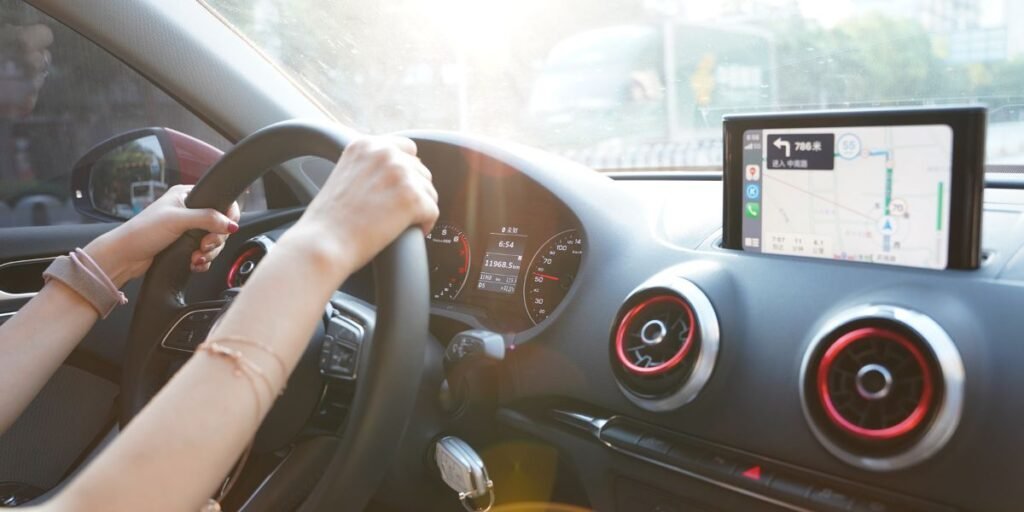
Practical Ways to Earn Extra Income
If you’re wondering how to make money with your car, this article is for you.
Many people search for extra income ideas, but often don’t realise their car could help.
A personal vehicle can become a handy tool for generating steady income: consider ridesharing, delivery gigs, advertising, peer-to-peer rentals, or even carrying commercial advertising on your car.
There are several trusted options out there. Most let drivers pick their own hours and decide how much they want to work.
The nice thing is, getting started usually just takes a reliable car and some paperwork. Drivers can sign up for rideshare companies, deliver food or groceries, or rent out their vehicles when they’re not using them.
Other ways to earn include car advertising or package delivery. Essentially, you can turn time behind the wheel into money if you choose to.


Key Takeaways
- A car can open up a meaningful income with numerous flexible options.
- Requirements and earning potential depend on the service you choose.
- A little prep work makes starting and earning more a lot easier.
DISCLAIMER: The content on this website is for informational purposes only and does not constitute financial, legal, or professional advice. While we strive to provide accurate and helpful information, results are not guaranteed. Always do your own research and consult with a qualified professional before investing your time or money in any opportunity.
How to Make Money with a Car

Getting Started: Requirements and Preparation
If you want to make money with your car, you’ll need to ensure it’s in good condition, meet the background requirements, and have the right insurance. You’ll also need to know your state’s laws and the rules of whatever company you’re signing up with for safety and legal reasons.
Vehicle Eligibility and Condition
Most companies want drivers to use a reliable, well-maintained car. Typically, vehicles must be less than 10–15 years old, have four doors, and pass safety inspections.
Cleanliness matters—a lot. Rideshare and rental platforms expect vehicles to have clean interiors and exteriors.
Maintenance means checking tires, brakes, fluids, and lights. Regular oil changes and quick repairs help keep things running and prevent headaches during jobs.
Some services require additional details, such as specifying the number of seats or trunk space. A car with fewer mechanical or cosmetic issues is more likely to be accepted.
Up-to-date registration and no outstanding recalls are often required as well.
Background Check and Driver Requirements
Most driving or delivery services make you pass a background check first. They’ll look at your driving record, check for a valid license, and make sure there are no serious criminal offences.
If you’ve had recent DUIs or lots of tickets, you might not qualify. Companies like Uber and Lyft usually want drivers to be at least 21 or 25 years old.
Previous driving experience is helpful, but not always necessary. You may also need a valid Social Security number and proof of residency, depending on your location.
Some services ask for proof of car ownership or details if you’re leasing or making payments on the vehicle.
Car Insurance and Legal Considerations
You’ll need active car insurance to work with rideshare, delivery, or rental platforms. Minimum liability coverage is standard, but requirements can vary.
Some companies want proof of commercial or rideshare insurance, while others offer extra coverage when you’re on the clock. Always notify your insurer if you plan to use your car for work; otherwise, claims may be denied.
It’s smart to keep your insurance documents current in case of an accident. Understanding local regulations is important, too. You might need a business license or permit for paid driving in some cities or states.
Ensure that you handle taxes, report your income, and follow company rules. For more details, check out Millennial Money Man and Small Business Trends.
Ridesharing Opportunities
Ridesharing offers genuine opportunities to earn extra money with your car. Drivers can choose their schedules, work independently, or assist groups such as children and seniors.
Driving for Uber and Lyft
Uber and Lyft are the largest rideshare apps in the U.S. They offer regular, premium, and carpool rides to cater to different needs.
Drivers can work at any time, day or night. That makes it easy to squeeze this side hustle into a busy schedule.
Pay depends on demand, distance, and time. Many folks earn decent hourly rates, especially during peak times.
The apps handle payments and typically allow drivers to cash out daily. Both Uber and Lyft require their drivers to meet specific vehicle standards and pass thorough background checks.
Customer ratings and bonuses for hitting trip goals can boost earnings. For more info on driving for rideshare apps, check out The Rideshare Guy.
Working as a Rideshare Driver
Driving for ridesharing offers flexibility and a pathway into the gig economy. You can accept or decline trips, so you control your workload and stress levels.
Most use their cars, but some lease through programs offered by rideshare companies. Many drivers use both Uber and Lyft, switching between them to get more ride requests.
Your earnings depend on your city, the time of day, and how efficiently you pick up passengers. You’ll need to keep a close eye on expenses, such as gas, insurance, and maintenance, to make it pay off.
Helpful tips: track all your costs, keep the car clean, and be friendly—good service often means better tips and ratings. For more strategies, see Career Sidekick’s rideshare driver guide.
Specialty Rideshare for Kids and Seniors
Some rideshare services focus on kids or seniors, which is a growing need. Companies like Wingz, HopSkipDrive, and Kango hire drivers who pass extra background checks and training.
Driving for these apps typically requires a spotless driving record and experience with children or older adults. Trips often include school pickups, doctor visits, or events.
Pay is often higher than regular rideshare, since there’s more responsibility. Scheduling may be less flexible, but jobs are typically planned in advance.
Families like these services for their reliability and safety. If you’re interested, review your local rules and any required certifications first.
Earning Extra Cash with Shuttle and Ride Services
You can also make money by running shuttle or ride services. This could mean set routes, airport shuttles, or group rides for events.
These services sometimes work outside the big rideshare apps. Some drivers team up with hotels, schools, or companies that need regular transport.
Check local licensing rules, since shuttle services may need commercial insurance or permits. Profits depend on filling seats and maintaining a schedule.
Some drivers take on extra work during busy periods, such as holidays or local events. For more ideas, see Money Crashers.
Food and Grocery Delivery with Your Car
Delivering food or groceries with your car is a popular way to earn extra money. Many drivers use major delivery apps for flexible schedules, making it a favorite side hustle.
Becoming a Food Delivery Driver
Food delivery allows you to use your car to bring meals directly to people’s doors. Apps like DoorDash, Uber Eats, Grubhub, Postmates, EatStreet, and Favor are big names here.
Signing up is usually quick and online. Drivers set their own hours, work when they want, and often keep all their tips.
Each app has its own requirements, but most need a background check, a valid license, and car insurance. Food delivery apps allow you to track your earnings directly within the app. Orders, maps, and customer addresses pop up right on your phone.
Some platforms offer alcohol delivery, which usually means you need to be over 21. Food delivery pays per order, and you can often get paid fast, sometimes the same day.
Earning with Grocery Delivery
Grocery delivery is another solid way to earn with your car. Apps like Instacart, Shipt, and Spark let you shop for and deliver groceries to people’s homes.
This job often means picking up shopping lists, shopping in-store, and then making the delivery. Grocery delivery can take longer per order, but drivers often get good tips, especially on big hauls.
Many grocery delivery services offer bonuses and pay increases during busy periods, such as weekends or holidays. Instacart, for example, has both full-service shoppers (who shop and deliver) and in-store shoppers (who just shop).
Grocery delivery is great for people who like shopping and want a more active gig. It’s flexible and can fit around your own schedule.
Maximizing Income Across Multiple Delivery Apps
If you want to earn the most, many drivers use multiple delivery apps simultaneously—this is known as multi-apping. With more apps, you get more delivery requests and avoid sitting around waiting.
For example, you might juggle DoorDash, Uber Eats, and Grubhub. If those are slow, you can switch to Instacart or Shipt for grocery runs.
Some even mix in package gigs, such as Amazon Flex. Keeping multiple apps open helps you stay busy and cherry-pick the best-paying orders.
Not every app allows overlapping shifts, so be sure to read the fine print. Tracking your mileage and expenses can help you save money at tax time as well. Multi-apping is a proven way to keep your schedule full, according to numerous drivers and blogs, such as Millennial Money Man.
Package and Parcel Delivery Services
Driving for delivery services is a fast and efficient way to earn money. With the right apps, anyone with a car can start delivering packages, help people move furniture, and run errands.
Delivering for Amazon Flex and Other Delivery Platforms
Amazon Flex allows individuals to use their own vehicles to deliver packages for Amazon. Drivers pick shifts that fit their schedules and can earn extra income.
Earnings depend on the number of completed deliveries, the area, and the time of day. Some days are busier than others, so it’s a bit unpredictable.
Other apps, such as Roadie and Instacart, as well as traditional courier platforms, connect drivers with package delivery jobs from stores or individuals. Most drivers work as independent contractors, setting their own hours and paying for gas and car maintenance themselves.
Below are some popular delivery platforms:
| Platform | Type of Work | Typical Pay |
|---|---|---|
| Amazon Flex | Amazon packages | $18–$25/hour |
| Roadie | Local package delivery | Up to $20/hour |
| Instacart | Groceries | Varies |
Delivering this way offers flexibility and can include bonus pay during busy times. There’s more about these top delivery jobs and apps if you want to dig deeper.
Specialized Delivery: Packages, Furniture, and Assistance
Some delivery jobs get more specific than just dropping off packages. Apps like Dolly and GoShare connect drivers with jobs that involve moving furniture, oversized items, or helping with loading and unloading.
Payment is typically higher for these tasks because they require more time or involve physical labour. If you’re willing to run errands or be a personal assistant through TaskRabbit, you might add even more to your income.
Drivers pick which jobs they want and sometimes work directly with local people. Being an independent contractor gives you freedom, but also means you’re on the hook for scheduling and keeping your car in shape.
For more on specialized delivery options, see tips for delivering packages with your car.
Car Sharing and Rental Platforms
Car sharing lets you earn extra money by renting out your car to others. These platforms help you turn an unused vehicle into a source of passive income.
List Your Car on Turo and Getaround
Platforms like Turo and Getaround make it easy to rent out your car to people in your local area. You create a profile, upload photos, set your price, and decide when your vehicle is available.
Insurance is usually included during rentals, which helps with peace of mind. On Turo, people rent cars for all kinds of reasons—road trips, special events, or business travel.
Some owners make a few hundred bucks a month, depending on the car’s type and condition. Listing your car is straightforward, requiring only basic information, photos, and proof of ownership.
If you want to see how it works, there’s more about how car sharing platforms help owners earn extra income.
Both Turo and Getaround handle payments and contracts, and they’ll often step in if there’s a dispute. An online dashboard allows you to track bookings and manage your listing at any time.
This type of passive income works best with reliable cars in good condition, as they tend to attract more renters.
Partnering with HyreCar for Rideshare Drivers
HyreCar connects car owners with people who want to drive for Uber or Lyft but don’t have a car. This service targets rideshare drivers and can bring in a steady stream of renters.
Owners list their car’s details and set any rules or restrictions. You set your own price, but it’s smart to check what others are charging in your area.
Insurance for rideshare use is included with the rental, so both parties are covered. Since rideshare drivers often need a car for days or weeks, you might see more consistent income, especially in busy cities.
Find more details about partnering with HyreCar to rent out your car to rideshare drivers.
Car Advertising and Branding Income
Car advertising is a way to earn passive income by turning your car into a rolling billboard. Companies pay you to display branded wraps or decals while you drive around doing your usual thing.
Getting Started with Carvertise and Wrapify
Carvertise and Wrapify are two big names in car advertising. Signing up is simple—fill out an online form.
Usually, you’ll need a clean driving record, a newer car in good condition, and a habit of driving in busy areas. Carvertise matches drivers with clients based on location and driving habits.
If you’re approved, they’ll wrap your car, and you could earn $100 to $300 per month, depending on the campaign and your driving habits. Payments are deposited into your bank account monthly.
Wrapify works a bit differently, tracking your miles with a mobile app. Depending on the coverage (light, partial, or full wrap), you may earn $180 to $450 or more per month.
Wrapify removes the wrap at the end of the campaign and doesn’t charge drivers any fees. Some folks check out Nickelytics, too—it’s another option for car ads.
Choosing the Best Car Advertising Opportunities
Not every car ad offer is legit. Real companies like Carvertise, Wrapify, and Nickelytics won’t ask you to pay to join or get started.
Steer clear of anyone demanding money up front or pushing expensive purchases. Your earnings depend on the ad size, your location, and the amount of driving you do.
Companies often prefer drivers in big cities who rack up a lot of miles. Some, like Carvertise and Wrapify, have strict mileage requirements to give brands maximum exposure.
Always check reviews before you sign up anywhere. Read the fine print, understand how long the wrap stays on, and ensure you know how and when you’ll get paid.
Specialized and Niche Car-Based Services
Some drivers boost their income by focusing on jobs that fill special needs. These gigs utilise vehicles such as SUVs, pickups, or vans for tasks that require extra effort or specialised skills.
Providing Pet Taxi and Childcare Transportation
A pet taxi service means you drive pets to vet visits, grooming, or daycare. Your car needs to be clean and safe for animals, with carriers or restraints to keep them secure.
Pet owners value drivers who understand animals, stick to schedules, and communicate well. Childcare transportation is another unique niche.
Parents sometimes need help getting kids to school, sports, or after-school activities. Sites like care.com connect families with drivers for these jobs.
For both, you’ll need to pass background checks and have solid references. The right insurance is a must, and many states have rules regarding the transportation of children or animals.
If you handle these jobs responsibly, you’ll probably see repeat business and strong ratings.
Offering Roadside Assistance or Junk Removal
Roadside assistance is a practical way for drivers with large vehicles or the right gear to earn money. You might perform jump-starts, change tires, or deliver gas to stranded individuals.
Some sign up with national companies, while others advertise locally. Junk removal means picking up unwanted stuff and hauling it to the dump or recycling center.
Trucks and SUVs work best for this. Many jobs are one-time, but if you’re polite and professional, word-of-mouth can bring in more business.
It’s helpful to keep gloves, straps, and tarps readily available for safety. Always check local rules—some places limit what you can haul or dump.
Helping People Move
Helping people move is a classic side gig for anyone with a truck, van, or roomy SUV. You might help with small moves—apartments, dorms—or transport furniture and boxes for short trips.
Most drivers book jobs through local ads, apps, or social media groups. Having a simple pricing list makes things clear for customers.
If you’re up for it, offer help loading and unloading—it adds value. Being reliable and on time is crucial.
Having sturdy moving blankets, straps, and a dolly makes the work safer and smoother. Careful, organized drivers tend to get better reviews and more repeat business.
For more niche ideas on using your vehicle for income, check out this list of side hustles.
Tips for Success and Maximizing Your Income
Making the most of your car comes down to managing your time, trimming expenses, and keeping everyone safe. Focusing on these can help you boost profits and dodge common headaches.
Essential Tips for Drivers
Picking the correct times to drive makes a big difference. Peak hours—mornings, evenings, weekends—usually mean more rides and better pay.
Using apps to track demand can help you find busy areas or events where people need rides. Mixing up your services brings more chances, too.
If you do ridesharing, you might also deliver food or packages. Some drivers even earn extra by wrapping their car with ads.
Keeping your car clean and looking good matters. A tidy interior and pleasant smell can mean higher ratings and more repeat customers.
It’s smart to carry water, snacks, or phone chargers—little things like that can boost tips and make customers happier.
Managing Expenses and Maintenance Costs
Tracking expenses is key if you want to stay profitable. Gas, insurance, and cleaning costs add up quickly, so keeping a budget helps avoid unexpected expenses.
Many drivers use apps or spreadsheets to monitor costs and spot ways to save. Staying on top of maintenance prevents expensive repairs.
Oil changes, brake checks, and tire rotations help keep your car running smoothly and reduce long-term costs. Follow your car’s service schedule to lower the risk of breakdowns.
Comparing insurance options can help you save money. Some companies have rideshare or delivery policies that cover both personal and business use.
Save your receipts—lots of expenses are tax-deductible.
Best Practices for Safety and Customer Service
Distracted driving is a considerable risk and can cost you money if you crash or miss work. Using a hands-free setup, focusing on the road, and following navigation instructions carefully helps keep everyone safer.
Good customer service leads to more tips and better ratings. Greet riders politely, ask about their comfort, and drive responsibly.
For deliveries, handle goods promptly and carefully. Always check passenger info before a ride, and lock your doors when it feels right.
Stay alert, especially at night. If something feels off, report it to the platform—it protects you and other drivers in the long run.
Evaluating Profitability and Long-Term Considerations
How much you make with your car depends on the service, your need for steady or flexible work, and how you adapt to changes like digital payments. Consider both short-term benefits and your long-term financial stability.
Comparing Earning Potential Across Services
Earning potential with a car depends on the service you pick. Rideshare apps like Uber and Lyft pay per ride. Delivery services like DoorDash and Instacart pay per delivery, and sometimes you get tips too.
Some drivers pull in more from premium services or by taking scheduled rides. It’s not always easy to predict, though.
When comparing, don’t forget to consider expenses. Fuel, maintenance, and insurance can quickly eat into your profits.
For a clearer picture, try tracking net income, gross profit, and the cost per mile. These numbers help you figure out what works for you.
Some services toss in bonuses or peak-time rates. That can boost your earnings, primarily if you work during busy hours.
A simple table makes the options easier to compare:
| Service Type | Average Earnings | Key Costs | Bonuses Available |
|---|---|---|---|
| Rideshare | Moderate-High | Fuel, Ins., Car | Yes |
| Food Delivery | Low-Moderate | Fuel, Wear & Tear | Sometimes |
| Package Delivery | Moderate | Fuel, Insurance | Rarely |
Think about how much time you want to spend driving. More hours usually mean more money, but you’ll rack up costs and put more wear on your car.
Getting a handle on these details helps you see the real profitability.
Balancing Flexibility and Consistency
Flexibility is a significant draw for many drivers. You can set your schedule, work around other jobs, or just log in during busy times to earn more.
Rideshare and delivery platforms often allow you to do your own thing. That’s a huge plus if you’ve got school or family commitments.
On the flip side, consistency means you know what you’ll make each week. Scheduled package delivery or contract driving typically offers steadier routes and more consistent pay.
This predictability can make planning bills and expenses a lot less stressful. It’s not for everyone, but some folks value that stability.
You’ll have to decide what matters most to you. Some people want the freedom to pick up gigs on the side, while others need a steady paycheck to cover the basics.
Honestly, choosing between flexibility and consistency can significantly impact your stress levels and how you manage your finances. It’s worth thinking through for long-term sustainability.
Exploring New Opportunities Like Cryptocurrency Payments
Some platforms now pay in cryptocurrency instead of regular cash. If you’re interested in digital assets, this might catch your attention.
Crypto payments sometimes land in your account faster than bank transfers. Additionally, some people believe that digital coins will be worth more in the future.
But let’s be real—there are risks. Crypto can lose value fast, and sometimes the fees to transfer or convert your earnings are higher than you’d expect.
You’ll also need to learn how to use wallets and keep your payments secure. That learning curve isn’t for everyone.
If you’re up for it, you might find extra perks. Accepting crypto could attract new customers or make cross-border jobs smoother.
Consider tax rules and value fluctuations before committing to cryptocurrency payments. This entire space is changing rapidly, so it’s best to remain cautious.
Frequently Asked Questions
You can use your own car to make money in all sorts of ways. Driving for apps, delivering food, or even putting ads on your vehicle—each method gives you different ways to boost your income and get more value from your car.
What are the top apps for earning money by using my own vehicle?
Uber and Lyft are go-to choices for rideshare income. Food delivery apps like DoorDash and Uber Eats allow you to deliver meals on a flexible schedule.
If you don’t need your car all the time, peer-to-peer rental platforms like Turo allow you to rent it out and earn money. For more details, check out these top ways to make money with your car.
How can I monetize my car through delivery services like DoorDash or Amazon Flex?
You can sign up as a delivery driver with companies like DoorDash, Uber Eats, Instacart, or Amazon Flex. These services pay you to deliver food, groceries, or packages to customers.
Your hourly earnings will change based on location and demand. Most platforms let you set your own schedule and work as much or as little as you want.
What are some effective strategies to make my car pay for itself?
Renting out your car on Turo can bring in steady passive income when you’d otherwise leave it parked. Placing advertising wraps on your car through companies like Wrapify or Carvertise pays you just for driving around.
Keeping good mileage records and taking care of your car helps you maximize earnings and keep expenses in check. This guide offers additional ideas for earning passive income with your car.
Can I realistically make a profit by driving my car across the country?
Some people do earn money with long-distance driving gigs, such as transporting vehicles or delivering goods between states. Your profit depends on factors such as fuel, tolls, wear and tear, and the job’s compensation.
Budget carefully—long trips can rack up extra costs that cut into your earnings.
How much can I expect to earn by advertising on my car?
Companies typically pay between $100 and $400 per month for car advertising, depending on where you drive, the number of miles you cover, and the size of the ad. Full car wraps pay the most.
If you drive in a big city with lots of traffic, you’ll probably get paid more since your car gets more exposure.
What are some reliable side hustles that involve the use of a car?
You’ve got a few solid options here. Driving for a rideshare company is probably the most obvious.
Some folks deliver food or groceries instead. If your car sits idle sometimes, you could consider renting it out.
There’s also moving stuff for people around town or picking up courier gigs. I’ve seen people mix and match these to hit their target income.
For even more ideas, check out this comprehensive list of ways to make money with your car.
Other articles
- How to make money with ads on your car
- The Secret to Business Success
- How to Start a Dog-Walking Business
- How to Start a Gardening Business with No Skills
- How to Start a Lucrative Carwash Business
- 9 Ways Teenagers Can Earn Money
- How to Make Money from Surveys
- Creative Ways to Make Money
- How to Make Money Fast
Copyright © Mann Island Media Limited 2025. All rights reserved.






